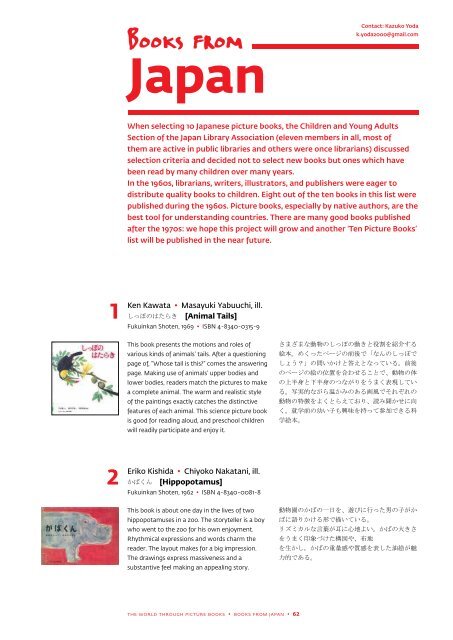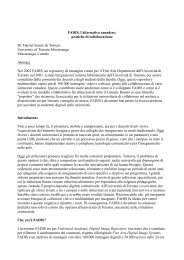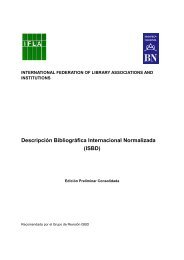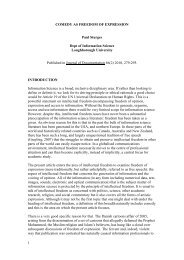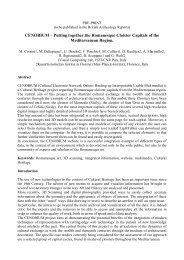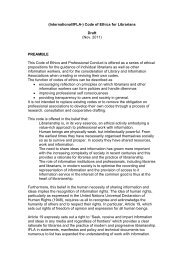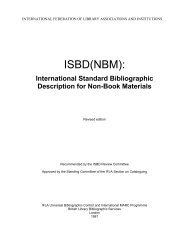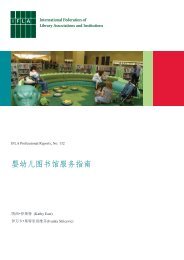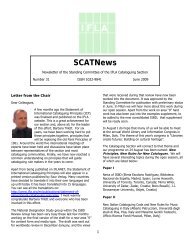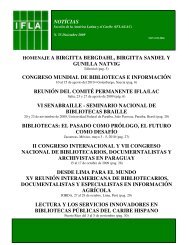English - IFLA
English - IFLA
English - IFLA
You also want an ePaper? Increase the reach of your titles
YUMPU automatically turns print PDFs into web optimized ePapers that Google loves.
1<br />
2<br />
Books from<br />
Japan<br />
When selecting 10 Japanese picture books, the Children and Young Adults<br />
Section of the Japan Library Association (eleven members in all, most of<br />
them are active in public libraries and others were once librarians) discussed<br />
selection criteria and decided not to select new books but ones which have<br />
been read by many children over many years.<br />
In the 1960s, librarians, writers, illustrators, and publishers were eager to<br />
distribute quality books to children. Eight out of the ten books in this list were<br />
published during the 1960s. Picture books, especially by native authors, are the<br />
best tool for understanding countries. There are many good books published<br />
after the 1970s: we hope this project will grow and another ‘Ten Picture Books’<br />
list will be published in the near future.<br />
Ken Kawata • Masayuki Yabuuchi, ill.<br />
しっぽのはたらき [Animal Tails]<br />
Fukuinkan Shoten, 1969 • ISBN 4-8340-0315-9<br />
This book presents the motions and roles of<br />
various kinds of animals’ tails. After a questioning<br />
page of, “Whose tail is this?” comes the answering<br />
page. Making use of animals’ upper bodies and<br />
lower bodies, readers match the pictures to make<br />
a complete animal. The warm and realistic style<br />
of the paintings exactly catches the distinctive<br />
features of each animal. This science picture book<br />
is good for reading aloud, and preschool children<br />
will readily participate and enjoy it.<br />
Eriko Kishida • Chiyoko Nakatani, ill.<br />
かばくん [Hippopotamus]<br />
Fukuinkan Shoten, 1962 • ISBN 4-8340-0081-8<br />
This book is about one day in the lives of two<br />
hippopotamuses in a zoo. The storyteller is a boy<br />
who went to the zoo for his own enjoyment.<br />
Rhythmical expressions and words charm the<br />
reader. The layout makes for a big impression.<br />
The drawings express massiveness and a<br />
substantive feel making an appealing story.<br />
the world through picture books • books from japan • 62<br />
Contact: Kazuko Yoda<br />
k.yoda2000@gmail.com<br />
さまざまな動物のしっぽの動きと役割を紹介する<br />
絵本。めくったページの前後で「なんのしっぽで<br />
しょう?」の問いかけと答えとなっている。前後<br />
のページの絵の位置を合わせることで、動物の体<br />
の上半身と下半身のつながりをうまく表現してい<br />
る。写実的ながら温かみのある画風でそれぞれの<br />
動物の特徴をよくとらえており、読み聞かせに向<br />
く。就学前の幼い子も興味を持って参加できる科<br />
学絵本。<br />
動物園のかばの一日を、遊びに行った男の子がか<br />
ばに語りかける形で描いている。<br />
リズミカルな言葉が耳に心地よい。かばの大きさ<br />
をうまく印象づけた構図や、布地<br />
を生かし,かばの重量感や質感を表した油絵が魅<br />
力的である。<br />
3<br />
4<br />
5<br />
Satoshi Kako<br />
だるまちゃんとてんぐちゃん [Little Daruma and Little Tengu]<br />
Fukuinkan Shoten, 1967 • ISBN 4-8340-0124-5<br />
Little Daruma and Little Tengu are good friends.<br />
Little Daruma asks his father, Darumadon, to<br />
let him put on the same things as Little Tengu.<br />
However, it’s not possible to have exactly the<br />
same things. So, Little Daruma works out<br />
a way to make similar things and becomes<br />
deeply satisfied. However, is it possible to make<br />
the same long nose as Little Tengu’s?<br />
This book clearly represents the psychological<br />
characteristics of a little child who wants to have<br />
the same things as his friend.<br />
Noboru Baba<br />
11ぴきのねこ [Eleven Hungry Cats]<br />
Koguma Publishing, 1967 • ISBN 4-7721-0004-0<br />
Eleven cats that are always hungry send a big,<br />
strong, and monstrous fish to sleep with a lullaby<br />
and catch it in a remote lake. However, the big<br />
fish, which is tied up to a raft, becomes a mere<br />
bone when the dark night is over. On the other<br />
hand, the cats’ stomachs become completely full<br />
and round like the stomachs of raccoons.<br />
The broad-minded story about cats who act as<br />
they wish, gets children’s sympathy. Additionally,<br />
the attached pictures have been attractively<br />
drawn by a cartoonist. Consisting of six volumes,<br />
the stories are widely appealing to children.<br />
Rieko Nakagawa & Yuriko Omura<br />
ぐりとぐら [Guri and Gura]<br />
Fukuinkan Shoten, 1967 • ISBN 4-8340-0082-6<br />
Two field mice, Guri and Gura, are fond of<br />
cooking and eating. They find a big egg in the<br />
forest. After talking, they decide to make a<br />
sponge cake. Gathering twigs, they build a fire<br />
place, and put a big pan on the fire. Then, a nice<br />
smell wafts into the forest and various kinds<br />
of animals gather around the fire. All the animals<br />
eat the softly baked cake.<br />
The theme of “eating”, which children like,<br />
and the conversational style of the book arouse<br />
children’s sympathy and lead them into the world<br />
of this picture book.<br />
the world through picture books • books from japan • 63<br />
だるまちゃんとてんぐちゃんは仲のいい友だちで<br />
す。だるまちゃんはてんぐちゃんと同じ物を身に<br />
付けたいと、お父さんのだるまどんにおねだりし<br />
ますが、ぴったり同じ物はありません。そこで、<br />
だるまちゃんはなんとか工夫して、そっくりの物<br />
を作って大満足。でも、てんぐちゃんの鼻と同<br />
じ、長い鼻を作ることはできるでしょうか。仲の<br />
いい友だちの真似をしたい、同じ物を身に付けた<br />
いという、幼い子どもの心理を鮮やかに表現し<br />
た作品。<br />
いつもはらぺこの11匹の猫たちは、遠くの湖で怪<br />
物のように大きくて強い魚を、なんと子守唄で眠<br />
らせて捕まえる。ところが、いかだに繋いだ大き<br />
な魚は、闇夜が明けた時には骨だけになってい<br />
て、その代わり、猫たちのお腹はタヌキのように<br />
まんまるに!思ったままに行動する猫たちのおお<br />
らかな物語は子どもたちの共感を呼ぶ。加えて漫<br />
画家が描く猫たちの絵は親しみやすく、愛嬌たっ<br />
ぷり。全6冊あるシリーズはどれも子どもたちに<br />
広く支持されている。<br />
お料理と食べることが大好きな、野ねずみのぐり<br />
とぐらは森で大きな卵を見つける。相談した結<br />
果、かすてらを作ることになった。かまどを作<br />
り、まきを集めて大きな鍋を火にかけて・・・。す<br />
ると森の中にいいにおいが広がって、動物たちが<br />
集まってきた。ふんわりや<br />
けたかすてらをみんなで食べる。幼い子が大好き<br />
な「食べる」というテーマや読者に語りかけるよ<br />
うな文体は、子どもの共感を誘い、リアリティの<br />
ある絵本の世界に引き込む。


